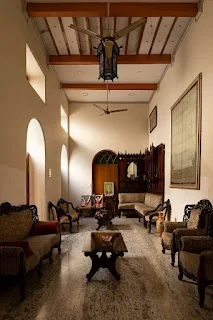Tucked away in a serene lane off the bustling Bank Street in Hyderabad's Koti, where 25 banks once shaped a legacy, lies a hidden gem frozen in time: the Raja Tarmakdas family kothi. Built in 1887, this 30,000-square-foot heritage home stands as a testament to the opulence of Hyderabad's elite during the Nizam era. Beyond its weathered walls and intricate arches, the kothi whispers stories of artistry, tradition, and a fleeting visit from one of India's greatest painters, Raja Ravi Varma.
Stepping into the kothi is like crossing a threshold into history. The structure, originally designed with 108 openings—doors, windows, and ventilators, a nod to the auspiciousness of the number nine—sprawls across two levels. Its architecture is a blend of Indo-European elegance, with high ceilings, teakwood beams, and jali work that filters sunlight into intricate patterns. The courtyard, once alive with the chatter of Hyderabad's aristocracy, now basks in quiet splendor, surrounded by verandas adorned with faded frescoes.
The kothi's interiors are a treasure trove of art and nostalgia. Rare Kalamkari textiles, their vibrant dyes telling tales of ancient craftsmanship, hang alongside glittering Tanjore paintings, their gold leaf embellishments catching the light. Pichwai artworks, with their intricate depictions of Krishna's divine pastimes, add a spiritual hue to the collection. Scattered among these are memorabilia from the Nizam's glory days—ornate silverware, handwritten letters, and faded photographs that evoke a time when Hyderabad was a cultural crucible.
The kothi's most storied chapter, however, belongs to Raja Ravi Varma, the legendary artist who revolutionized Indian portraiture. In the early 1900s, Varma spent 40 days here, commissioned to paint a portrait of the Nizam. The monarch, known for his discerning taste, famously rejected the artwork—a decision that now feels like a footnote in the kothi's rich legacy. One can almost imagine Varma at work in the airy upper chambers, his brush capturing the essence of a bygone era, the scent of turpentine mingling with the fragrance of jasmine from the gardens below.
Today, the Raja Tarmakdas kothi stands as one of Hyderabad's last surviving havelis, a quiet guardian of the Nizams' cultural splendor. Its walls, though weathered by time, hold stories of artistry, ambition, and a city that once dazzled the world. For those who wander its halls, it's not just a home—it's a living canvas, painted with the hues of history.












No comments: